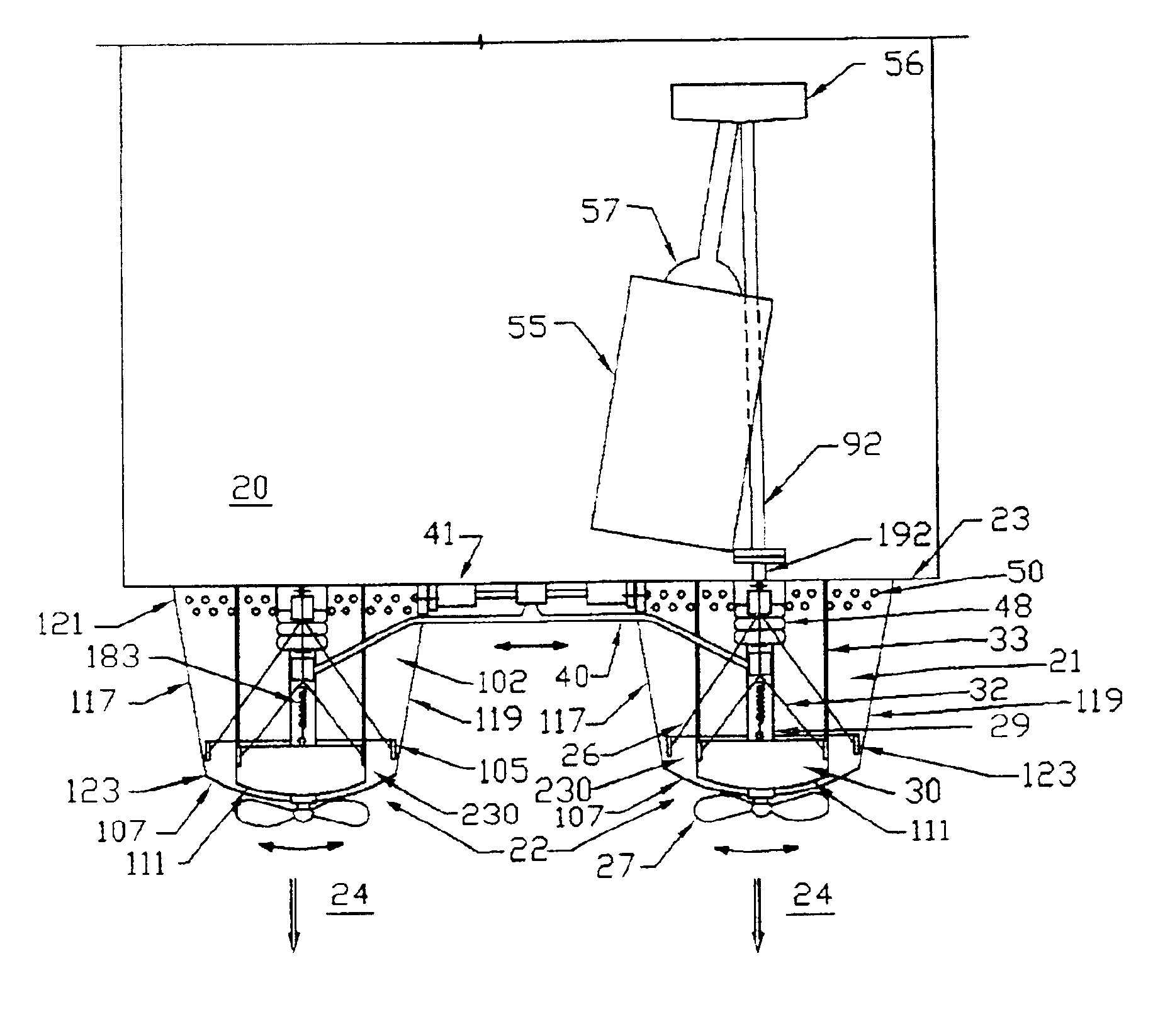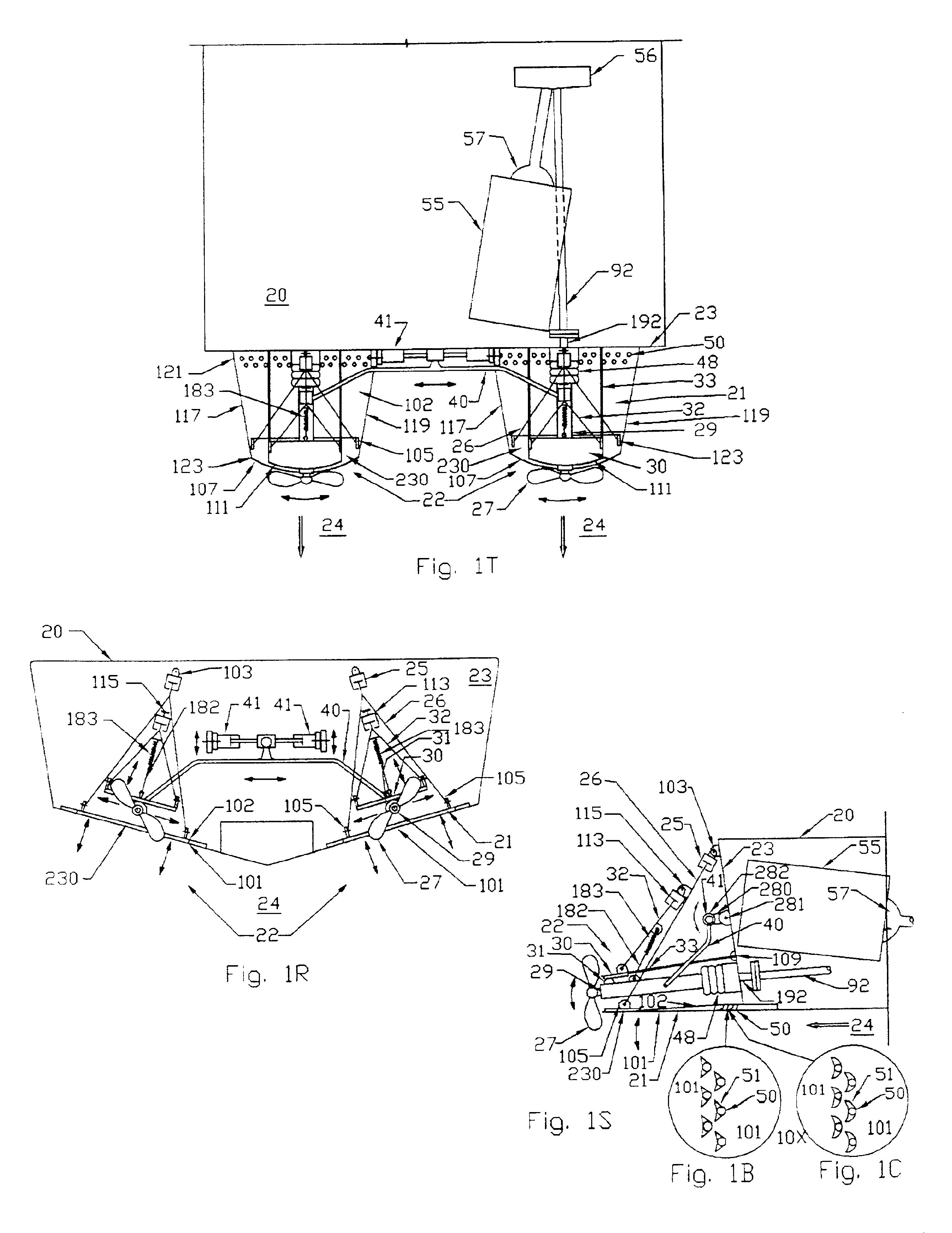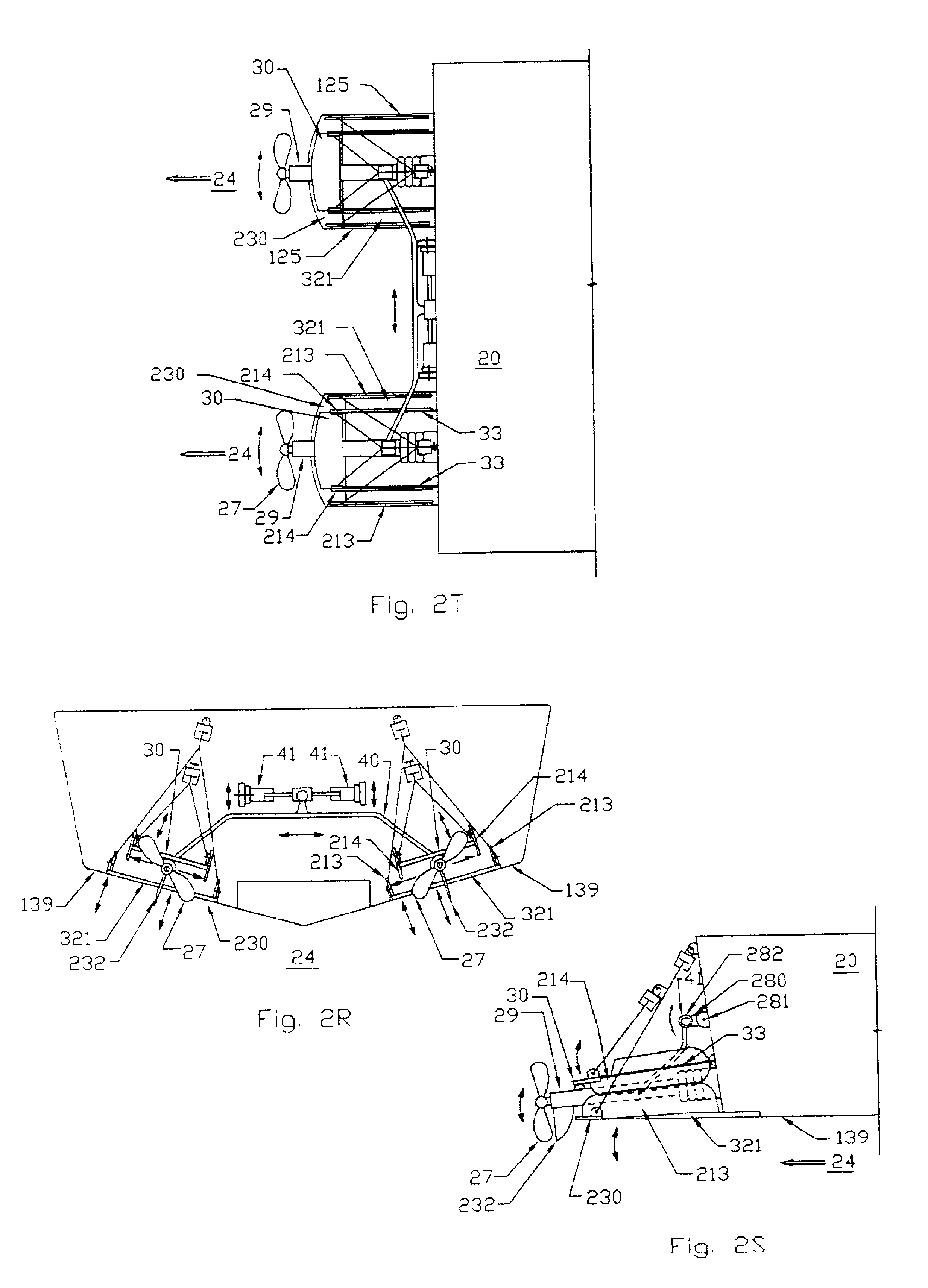The term "trim angle" often leads to
ambiguity as to whether it is the angle of the boat, or the tabs, or the outdrive being discussed.
When underway, water rushes under the boat, causing the rear of the boat to be deflected up or down by the trim tabs.
It is noted, however, that the "up on the tabs" operation of prior art trim tabs has limited effectiveness.
Prior art trim tabs are only somewhat effective in changing the attitude of the boat.
A major deficiency of flat plate hinged tabs is that the up tab position causes an abrupt change in the contour of the surface running on the water.
As with any airfoil, flow separation causes loss of lift.
The hinged flat plate is simply a crude airfoil with poor lift to drag ratio and is not very successful at raising the
nose of the boat.
Although somewhat superior to hinged plate designs, the bending flat plate also has excessive drag for the amount of lift generated.
This method of changing the attitude of the boat and lifting or depressing the stem of the boat by changing the thrust angle of the propulsion is not as efficient as optimizing the thrust vector to be essentially parallel to the direction of travel and then adjusting the
hull geometry to optimize the hydrodynamic lift to drag ratio.
The steering sweep is somewhat effective, but the vertical sweep for controlling trim is rather deficient.
The skeg is also intended to contribute to the steering, but because a surface drive has a steerable thrust vector, the skeg has only a minimal contribution to the steering, especially when under power.
The skeg imposes undesirable drag and also slices a groove in the water as the water approaches the
propeller blades.
In this manner, the skeg causes a major disruption in the homogeneous flow field of water into which the blades are progressing as the propeller screws itself into the water.
Although there is a performance penalty due to the drag forces of the skeg in the water, there is an added performance penalty over and above that simple drag force due to the field disruption and
aeration of the water ahead of the propeller.
A propeller designed to be nonventilating does not work well in a ventilating mode and conversely, a propeller designed to operate in the ventilating mode, which is sometimes referred to as "hyperventilating" mode, does not work well in a nonventilating mode.
Surface drives have a
disadvantage of not backing up very well.
This is caused by the propeller back wash impinging on the transom of the boat and nullifying the reversing thrust.
Surface drives also have a
disadvantage of presenting an exposed propeller at the surface of the water such that a passenger could fall into contact with the blades more easily than with submerged propeller type of drives.
However, as previously discussed, the vertical
thrust vectoring of the propulsion
system is inefficient compared to the preferred trimming of the hull through the use of trim tabs.
Using the up trim on a surface drive has a very weak effect on the attitude of the boat and usually only tends to pull the propeller too far out of the water causing the engine to overspeed.
Using the down trim imnmerses the propeller too far into the water causing the engine to slow down due to overload.
The difficult part of controlling this bite is that the
water depth on the surfacing propeller is influenced by wave action, boat bounce, comering, or speed changes.
However, sporadic changes in bite are not desirable because it is hard on the drive
train, it makes the boat difficult to control, and it may be dangerous to the occupants.
Another
disadvantage of surface drives is that they tend to crawl sideways due to having only the
lower half of the propeller in the water, which thus imparts a net sideways force on the propeller.
This side motion can be chronic, unpredictable, and fatiguing to the driver.
Another disadvantage of surface drives is that the boat tends to struggle to get up on plane.
Because the torque output of an engine is low at low
revolutions per minute (RPM) and because the propeller is fully immersed, or "flooded", at low speeds, surface drive boats often have a difficult time getting over "hump speed", which is that speed when the boat actually starts to plane and the drag forces tend to decrease.
Another disadvantage with surface drive boats is they may tend to "blow over" at high speeds.
Although other high speed boats also blow over, the surface drive may be worse in that, as the bow of the boat starts to rise up, the extended propeller is dunked under the water surface as the boat tends to rise up on its bottom surface at the
stern thus adding to the blow over condition.
Prior boat designs do not address the changing bite associated with wave action, or hull bounce, or changes in speed, or the fact that the plane of water leaving the bottom of the craft when turning is not in the same plane as when the craft is traveling in a straight line.
Prior designs do not address the uncontrolled bite problem.
As with any surface in contact with the water, these trim tabs will cause undesirable drag forces, and there are circumstances when the boat is traveling well without need for any up or down trim, that is to say, it would be best if the trim tabs disappeared.
Having a surface with
high lift and high drag is usually no better than having a surface with no lift and no drag.
It must be noted that detachment, and maybe even modification of the boundary layer has resulted in loss of the desirable negative lift using devices of prior art.
It is recognized that the mounting of the trim tab to the bottom surface of the hull provides an ideal
cantilever situation for some boats, however, there are some bottom surfaces which are highly irregular which may make the mounting difficult.
One of the deficiencies of current surface drives, without present invention, is that their trim controls do not perform well, that is to say, raising the "up" trim mechanism only serves to pull the propeller out of the water thus causing the motor to over speed, and lowering the "down" trim mechanism only serves to fully immerse the propeller and thus overload the engine, while neither serves well to change the planing attitude of the boat.
A boat with traditional surface drives often has difficulty getting over "hump" speed because the propeller is fully immersed, or "flooded", and the torque of the motor is generally low at low speeds.
Despite the taming effect of these bias fins, they do impose an added drag force penalty to the
system.
However, many high performance boaters are modifying both of these drives by raising them higher on the transom such that they operate as surface drives, but as with other surface drives, the attitude of the boat is no longer effectively changed by tilting the thrust vector as was done before.
 Login to View More
Login to View More  Login to View More
Login to View More 


